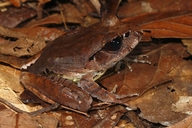|
Mixophyes coggeri Mahony, Donnellan, Richards & McDonald, 2006
| family: Myobatrachidae subfamily: Limnodynastinae genus: Mixophyes |
| Species Description: Mahony M, Donnellan S, Richards S, McDonald 2006 Species boundaries among barred river frogs, Mixophyes (Anura: Myobatrachidae) in north-eastern Australia, with descriptions of two new species. Zootaxa 1228:35-60. | |
 © 2013 Nathan Litjens (1 of 6) |
|
|
|
Description Diagnosis: Can be distinguished from other members of the Mixophyes schevilli species complex by the following combination of characters: 0-9 large irregular pale blotches with dark borders, 1-11 mm in diameter, concentrated on the distal thigh for M. coggeri vs. 1-13 symmetrical pale blotches with dark borders, 1-6 mm in diameter, concentrated on the distal thigh for M. schevilli, or posterior surface of thighs uniformly dark with many small pale rounded spots (9-35 spots per thigh, 1.0-1.7 mm in diameter), evenly distributed along the length of the thigh for M. carbinensis. In M. carbinensis the patterning on the dorsal and posterior surfaces of the leg is more visible as it contrasts more strongly with the ground color than in M. schevilli and M. coggeri (Mahony et al. 2006). Description: Adult males measure 81-92.5 mm SVL. Adult females measure 74-104 mm SVL. Flat head with relatively small eyes and a prominent round snout. Well-defined, straight canthus rostralis with slightly concave loreal region below the canthus. Tympanum is distinct, large and oval-shaped. Rectangular tongue, no posterior notch. Vomerine dentigerous processes in two relatively long straight rows from anterior margin of choanae to midline between choanae. Fingers are long and slender and lack webbing. Prominent subarticular and palmar tubercles. Relative finger lengths III>IV>I>II. Moderately long hind legs. Webbed toes. Toe IV is fringed with web on distal two phalanges. Subarticular tubercles on Toes I-II only. Prominent inner metatarsal tubercle with well-defined outer edge; outer metatarsal tubercle is lacking. Smooth dorsum and venter. Males have brown glandular nuptial pad on inner palmar tubercle and along the entire length of Finger I except for the finger disc (Mahony et al. 2006). In life, dorsal surfaces of body and limbs ranges from light beige to copper brown or dark brown. Mid-dorsal stripe, dorsal patches, patches on the face, and limb barring are darker or richer brown than the ground color. Mid-dorsal stripe may have internal light patches or large dark blotches, with some parts of stripe and blotches bordered with black or white. Dorsal and facial patches may have a thin cream-colored border, with the center of the patches lighter than the edges. Dark lateral stripe on the head may extend to the axilla, and is bordered by a thin cream-colored line that stands out against the black stripe but shades into the ground color. Tympanum is darker than ground color and lacks a light border. Upper lip may have small dark blotches. Suborbital small black patches. Lateral triangular patch (dark brown or black with a lighter brown center) extending from the naris to the jaw. Upper limb surfaces may be barred with fine black margins on the bars. Triangular dark brown to black patches on limb sides. Posterior surface of thigh has 0-9 large pale blotches (1-11 mm in diameter) with a dark border; blotches are concentrated on the distal section of the thigh. Ventral surfaces (except for limbs) white with yellow hue. Chin is lemon-yellow, sometimes with gray hue (dusky) around margins of the chin and towards the jaw articulation. Ventral surfaces of the limbs are off-white. Fingers and toes are the same shade of brown as the dorsum. Webbing between the toes is black. Iris dark brown. Nuptial pad of males is gray to brown (Mahony et al. 2006). In preservative, dorsum is a dark chocolate brown. Broad, dark brown inter-orbital bar becomes a mid-dorsal stripe with uneven lateral margins and black edging, with a few small pale patches in the midst of the stripe, extending to mid-sacral region. Dorsum has small dark flecks lateral to the mid-dorsal stripe. Dark lateral head stripe runs from the nostrils past the tympanum, covering the posterior margin of the tympanum. Dark brown triangular patches found on the lateral edges of all limbs. Hindlimbs and arms have dark brown dorsal surfaces with narrow darker brown transverse bars. Irregularly shaped pale blotches (0-9 blotches on each thigh, 1-11 mm in length) with dark margins on the posterior of the thigh, along with fine speckling. Dark brown palms and soles (Mahony et al. 2006). Distribution and Habitat Country distribution from AmphibiaWeb's database: Australia
Life History, Abundance, Activity, and Special Behaviors Trends and Threats Comments The specimen from Mt. Lewis has a mtDNA haplotype consistent with M. carbinensis rather than with the other specimens of M. coggeri, while its allozymes, morphology and meristics are characteristic of M. coggeri. It is not clear whether this inconsistency is due to introgression between M. carbinensis and M. coggeri on the Carbine Tableland; however, the allozyme profile matches M. coggeri at nine loci, which means if there had been introgression this individual must be a late generation backcross. Mislabeling cannot be excluded as an alternative possibility (Mahony and Richards 2006). The specific epithet honors Professor Harold George Cogger, formerly deputy director of the Australian Museum, for his contributions to herpetology (Mahony et al. 2006).
References
Mahony, M., Donnellan, S. C., Richards, S. J., and McDonald, K. (2006). ''Species boundaries among barred river frogs, Mixophyes (Anura: Myobatrachidae) in north-eastern Australia, with descriptions of two new species.'' Zootaxa, 1228, 35-60. McDonald, K., Richards, S., and Alford, R. (2008). Mixophyes coggeri. In: IUCN 2010. IUCN Red List of Threatened Species. Version 2010.1. www.iucnredlist.org. Downloaded on 21 May 2010. Originally submitted by: Stephanie Ung (first posted 2009-10-22) Edited by: Kellie Whittaker (2010-05-21) Species Account Citation: AmphibiaWeb 2010 Mixophyes coggeri <https://amphibiaweb.org/species/6754> University of California, Berkeley, CA, USA. Accessed Nov 29, 2024.
Feedback or comments about this page.
Citation: AmphibiaWeb. 2024. <https://amphibiaweb.org> University of California, Berkeley, CA, USA. Accessed 29 Nov 2024. AmphibiaWeb's policy on data use. |


 Map of Life
Map of Life